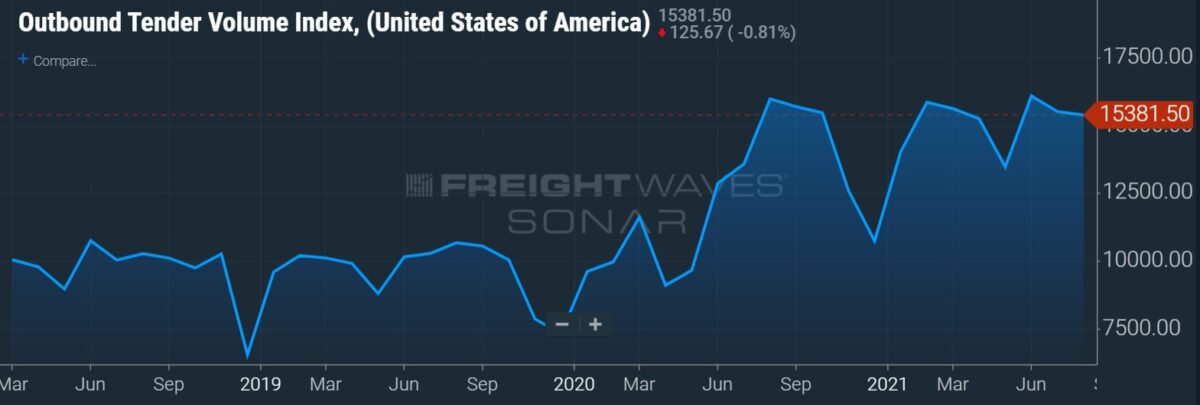In its third-quarter economic outlook, Chattanooga, Tennessee-based truckload carrier U.S. Xpress calls for favorable trucking fundamentals to remain in place through year end. Pointing to the combination of outsized freight demand and diminished capacity, the carrier expects volumes and rates to remain elevated “through 2021 before turning deflationary in Q1 of 2022.”
However, even when demand cools, the company expects headwinds finding drivers will continue.
U.S. Xpress’ (NYSE: USX) updated outlook is that the strength in freight volumes will carry through the third quarter with some capacity coming back into the market as COVID-related unemployment benefits end. While capacity is expected to continue to slowly bleed back into the market, it is unlikely to materially change the supply-demand dynamic in existence since last peak season.
“As the economy recovers and the holiday season draws near, the trucking industry will have to reckon with another spate of elevated freight volumes this fall,” the report stated.

On the driver front, the report pointed to fleet sizes, which have been reduced by mid-single-digit percentages throughout the pandemic, as a hurdle that will need to be overcome. A number of potential workers remaining on the sidelines, possibly the result of enhanced unemployment payments, and roughly 50,000 drivers venturing off to operate under their own authority, are the primary obstacles. The report concluded that these catalysts make “any quick relief for the driver shortage” unlikely.
Even after a full year of peak-like conditions, carriers are still rejecting more than 20% of loads tendered under contract. The main reason for the high level of turn downs is a lack of seated tractors available to meet the demand.
The report highlighted a tight correlation between spot market rates and contractual rates. As shippers continue to lean on spot market capacity to move freight, spot rates have remained elevated. The company said a continuation of a broad economic recovery along with driver capacity constraints are expected to lead to higher contract rates.
“These conditions are expected to continue to support spot market rates in excess of contract rates and a strengthening contract renewal environment through the remainder of 2021.”
“Without a doubt, a drop in the spot market is going to come,” the report continued. “What remains to be seen is whether it’ll happen in the winter, spring, or summer of 2022. Moreover, will the decline in rates come as a result of easing freight volumes or an unanticipated surge of new drivers? Or, will it be rooted in a perfect storm of both factors? Further, will a deflationary rate environment arrive in the form of a sudden, steep downhill grade or a moderate, drawn-out decline?”
Assuming no large entrance of drivers or a steep decline in consumer demand, “the post-COVID ‘trough’ during the next rate cycle could still land on rates that, in normal times, freight markets of the past would have considered ‘peak’ rates. After all, carriers across the country have tapped into every incentive imaginable to coax drivers off of the sidelines, to no avail.”
Risks to the trucking boom
Some risks were pointed out as detractors to U.S. Xpress’ third-quarter forecast.
The upheaval in the supply chain due to extreme conditions — soaring demand and contracting capacity — remains front and center. “Supply chain disruptions have impacted capacity, which impacts fleet productivity, which in turn exacerbates the aforementioned supply chain issues,” the report stated.
Retail inventories remain well off normal levels when compared to sales. Inventory replenishment has been and will continue to be complicated by materials shortages and a lack of labor. The intensity with which product is being pulled by consumers through the supply chain could be interrupted due to these issues, prematurely ending the peak of the current freight cycle.
Inflation was called out as well.
“There are many encouraging signs and reasons for optimism, but growth can’t be taken for granted,” the report added. “If businesses must raise wages in order to motivate people to return to work, that could very well fan the flames of long-term inflation. If inflation becomes a serious issue, the Federal Reserve may be forced to move aggressively by raising interest rates in order to tamp down economic growth.”
“These factors will continue to significantly impact carriers and shippers alike for the months to come, but as vaccination rates increase and the economy continues to re-open, we’re hopeful for a positive impact to the supply chain,” said Eric Fuller, president and CEO.
U.S. Xpress missed second-quarter expectations last month due to labor headwinds and higher costs associated with the rollout of its digital fleet, Variant.
The economic outlook report, which wasn’t issued as earnings guidance, appears to have been viewed favorably by investors. Shares of USX are up 2.5% over the past two sessions compared to the S&P 500 (+0.8%) and several other TL stocks, which were up or down only slightly.
Disclosure: FreightWaves founder and CEO Craig Fuller retains ownership of U.S. Xpress shares through his family trust.
